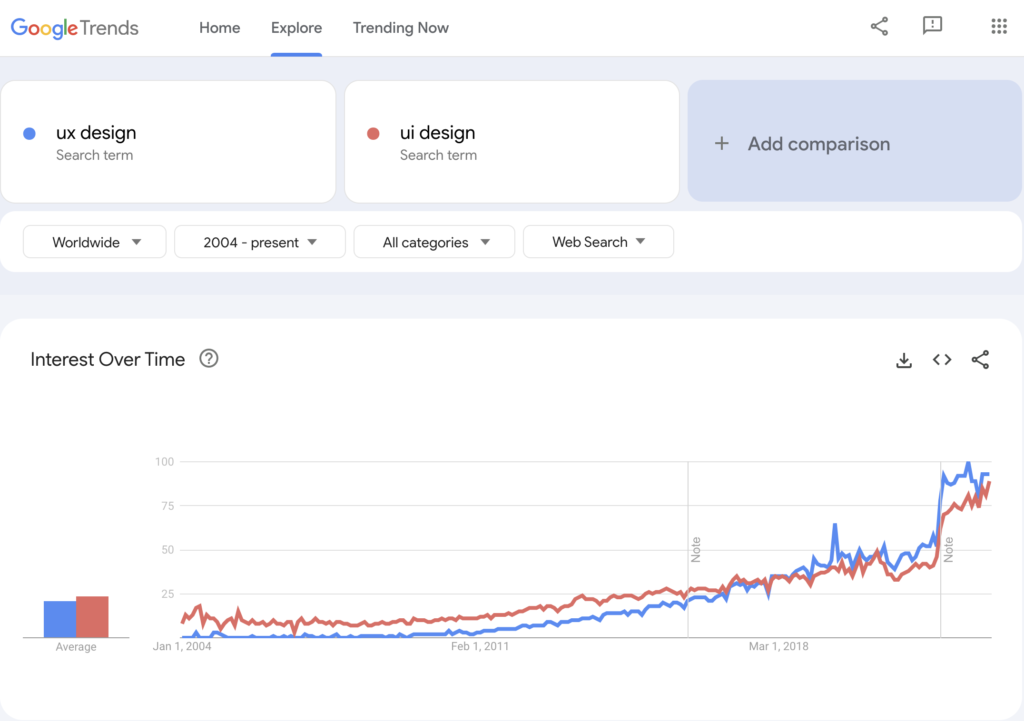In today’s digital age, user experience (UX) has become a critical factor in the success of any business. The rise of smartphones, tablets, and other digital devices has led to an explosion of apps, websites, and other digital products. To stand out in this crowded market, businesses need to deliver exceptional user experiences to their customers. As a result, the demand for UX designers has skyrocketed in recent years. In this blog post, we’ll explore the current demand for UX designers in today’s job market and why it’s a great time to pursue a career in UX design. Whether you’re a recent graduate or considering a career change, read on to learn more about the opportunities available in this exciting field.

Even with no experience, you can get a job as a UX/UI designer, all it takes is a combination of passion, determination, and a strategic approach to building your skills and experience. While having prior experience can certainly help you land a job as a UX/UI designer, it’s not necessarily a requirement. With the right mindset and approach, you can overcome the challenge of breaking into the field without experience. In this blog post, we’ll share tips and strategies for how to get hired as a UX/UI designer with no experience. Whether you’re starting from scratch or looking to make a career transition, we’ll guide you through the steps you can take to build your skills, create a standout portfolio, and gain practical experience that will make you a strong candidate for entry-level UX/UI design jobs. So, let’s dive in and explore how you can kickstart your career in UX/UI design, even if you don’t have any prior experience.
Step 1: Learn the basics – What is UX design?
User experience (UX) design is the process of creating digital products or services that are intuitive, easy to use, and enjoyable for the user. The primary goal of UX design is to create products that meet the needs of the user while also achieving business objectives. This involves a deep understanding of user behavior, psychology, and design principles.
UX designers work closely with product managers, engineers, and other stakeholders to define the product strategy, develop user personas, and conduct user research. They use this information to create wireframes, prototypes, and designs that can be tested and refined before the product is launched.
The UX design process is iterative, meaning that designers continually refine and improve the design based on user feedback and testing. This process helps to ensure that the final product is user-friendly, intuitive, and meets the needs of the target audience.
UX design is a multidisciplinary field that draws on a range of skills, including research, design, psychology, and technology. UX designers need to have a deep understanding of user behavior and psychology, as well as strong design and problem-solving skills. They must also be able to work collaboratively with cross-functional teams to deliver products that meet the needs of both users and businesses.
What skills do UX/UI designers need?
- User research:
UX/UI designers must have a deep understanding of the users they are designing for. This involves conducting user research to identify user needs, behaviors, and pain points. UX/UI designers must know how to gather and analyze user data to inform design decisions. - Wireframing and prototyping:
UX/UI designers use wireframing and prototyping tools to create low-fidelity and high-fidelity designs. These tools help designers visualize the structure and layout of a design, test usability, and gather feedback. - Visual design:
Visual design is the art of creating beautiful and functional interfaces. UX/UI designers need to have a strong grasp of typography, color theory, and visual hierarchy to create designs that are aesthetically pleasing and easy to use. - Interaction design:
Interaction design is the process of defining how users interact with a product. UX/UI designers must know how to create intuitive and easy-to-use interfaces that enable users to accomplish their goals. - Coding:
While not always a requirement, knowing how to code can be a significant advantage for UX/UI designers. Understanding front-end development languages like HTML, CSS, and JavaScript can help designers create designs that are both beautiful and functional. - Collaboration:
UX/UI designers must be able to work collaboratively with other members of a product team, including product managers, engineers, and other designers. Collaboration involves effective communication, compromise, and the ability to receive and incorporate feedback.
What tools or software do aspiring UX/UI designers need to become familiar with?
UX/UI designers use a variety of tools to create designs, prototypes, and wireframes. Here are some of the most common tools used by UX/UI designers:
- Sketch: Sketch is a popular design tool used by many UX/UI designers. It’s a vector-based design tool that allows designers to create high-fidelity designs and wireframes.
- Adobe Creative Suite: Adobe Creative Suite is a collection of design tools, including Photoshop, Illustrator, and XD, that are commonly used by UX/UI designers. These tools allow designers to create visual designs, logos, and other graphics.
- InVision: InVision is a prototyping tool that allows designers to create clickable prototypes and animations. It’s a great tool for testing usability and gathering feedback.
- Figma: Figma is a web-based design tool that allows designers to collaborate on designs in real-time. It’s a great tool for remote teams and offers features such as commenting, sharing, and version control.
- Axure: Axure is a prototyping tool that allows designers to create complex and interactive prototypes. It’s a great tool for designing and testing user flows and information architecture.
- Balsamiq: Balsamiq is a low-fidelity wireframing tool that allows designers to quickly sketch out ideas and concepts. It’s a great tool for ideation and getting feedback early in the design process.
- Usability testing tools: UX/UI designers also use a variety of usability testing tools to gather feedback from users. These tools include UserTesting, Hotjar, and Optimal Workshop.
Step 2: Building Your UX/UI Portfolio, even without experience
A strong portfolio is an essential component of any successful UX designer’s career. It’s the first thing that potential employers or clients will see, and it’s often the deciding factor in whether or not they choose to work with you. A well-crafted portfolio can showcase your design skills, creativity, and problem-solving abilities, and demonstrate your ability to create user-centered designs.
Here are some reasons why having a strong portfolio is crucial for UX designers:
- Demonstrates your design process: A portfolio provides insight into how you approach design challenges and how you solve problems. By including case studies and showcasing your design process, you can demonstrate your ability to think critically and create user-centered designs.
- Showcases your design skills: A portfolio is an opportunity to showcase your design skills and aesthetic sense. This includes your ability to create visually appealing designs that are easy to use and intuitive for users.
- Proves your experience: A strong portfolio can demonstrate your experience in the field of UX design. This can include examples of projects you’ve worked on, the problems you solved, and the results you achieved.
- Helps you stand out from the competition: In a competitive job market, having a strong portfolio can help you stand out from the competition. It shows that you’re serious about your career and that you’re invested in improving your skills.
- Builds trust with clients or employers: A portfolio can help build trust with clients or employers by demonstrating your abilities and your commitment to your craft. This can make it easier to win new clients or secure job offers.
Creating your first UX design projects, with no experience
Creating your first UX design project can seem daunting, especially if you’re starting with no experience. However, it’s an essential step to building your skills, gaining experience, and building your portfolio. Here are some tips for creating your first UX design projects:
- Choose a simple project: Start with a simple project that won’t overwhelm you. For example, design a landing page for a fictional company or a simple app that solves a basic problem.
- Define the problem: Every good UX design project starts with a problem. Define the problem you’re trying to solve and make sure it’s relevant and meaningful.
- Conduct user research: Conduct user research to understand your target audience and their needs. This can include surveys, interviews, and usability testing.
- Create user personas: Use the data from your research to create user personas. User personas are fictional representations of your target users and help you design for their needs.
- Sketch ideas: Sketch out your initial ideas for the project. This can include wireframes, flowcharts, and other visual aids to help you plan your design.
- Create prototypes: Use design tools such as Sketch or Figma to create prototypes of your design. Prototypes allow you to test your design and gather feedback from users.
- Iterate: Use the feedback you receive from users to iterate on your design. This can involve making changes to the layout, the visual design, or the functionality of the project.
- Showcase your work: Once you’ve completed your project, add it to your portfolio to showcase your work to potential employers or clients.
Tips for creating a compelling UX design portfolio
Step 3: Gaining Practical Experience without prior experience
- Finding internships or entry-level positions to gain practical experience
- Networking and making connections in the UX design community
- Volunteering your UX design skills to non-profit organizations
Step 4: Upskilling with Online Courses
- The benefits of online courses for learning UX design skills
- The best online courses and resources for learning UX design
- How to showcase your online learning experience on your resume and portfolio
Attending Industry Events
- The importance of attending industry events for networking and learning
- Tips for finding and attending industry events as a UX designer
- How to make the most of your attendance at industry events
VII. Conclusion
- Recap of the key points covered in the blog post
- Encouragement to take action and pursue a career in UX design
- Final thoughts on getting hired as a UX designer with no experience.
